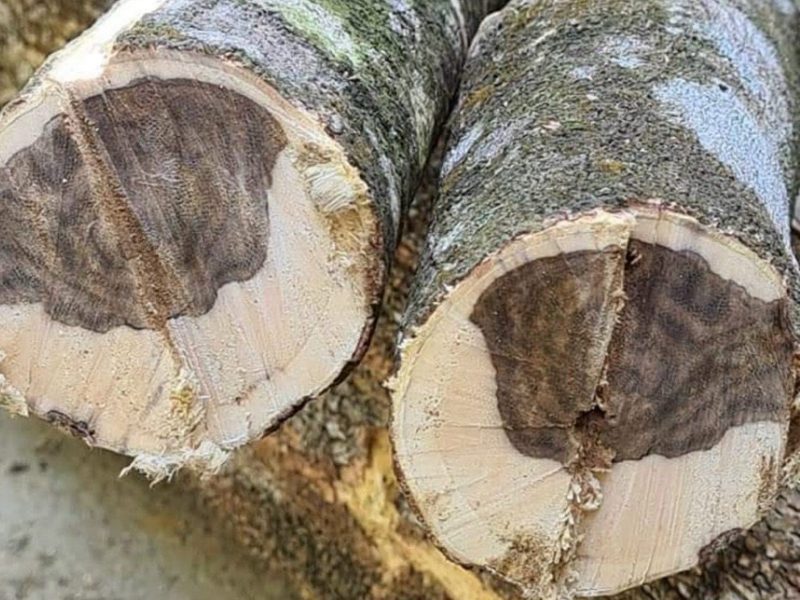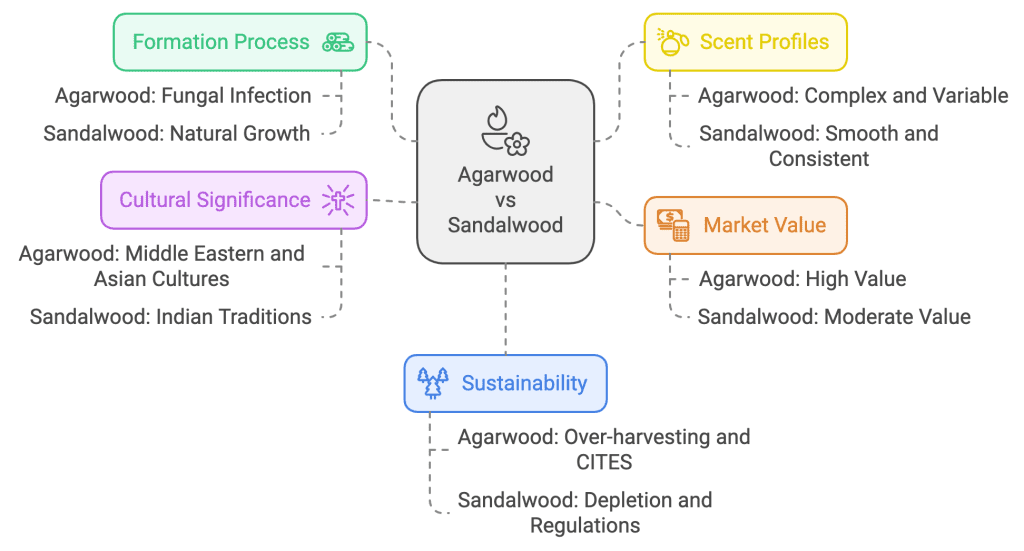
I. Introduction
Table of Contents
ToggleThe world of aromatic woods is rich and diverse, playing a significant role in various cultures and industries throughout history. From sacred rituals to modern perfumery and traditional medicine, these woods have been cherished for their unique scents and properties. Among them, agarwood and sandalwood stand out as two of the most revered and sought-after fragrant woods. This article aims to provide an aromatic woods comparison, focusing on the differences between agarwood and sandalwood, and exploring their unique qualities, uses, and cultural significance.
“To understand more about the varieties of agarwood, refer to our article on Types of Agarwood and Identification Characteristics.”
II. Understanding Agarwood
Origin and Formation
Agarwood, also known as oud or gaharu, is a rare and valuable fragrant wood formed in the heartwood of Aquilaria trees. When these trees become infected with a specific type of mold, they produce a dark, resinous wood as a defense mechanism. This process can take several years, contributing to agarwood’s rarity and high economic value. The combination of the infection and the tree’s response results in a complex and highly prized scent characteristic that is unmatched by other woods.

Properties and Uses
The scent characteristics of agarwood are deep, rich, and multifaceted, featuring notes that are sweet, woody, and slightly spicy. Its unique aroma complexity makes it a coveted ingredient in high-end perfumery and incense. Additionally, agarwood holds a significant place in traditional medicine across Asia, where it is used for its purported therapeutic properties, including stress relief and enhancing meditation practices.

III. Understanding Sandalwood
Origin and Varieties
Sandalwood comes from the genus Santalum and is renowned for its smooth, creamy fragrance. The most famous varieties are Indian sandalwood (Santalum album) and Australian sandalwood (Santalum spicatum). These trees are native to India, Australia, and other parts of the Pacific, and they are semi-parasitic, deriving some of their nutrients from the roots of other plants. Sandalwood has been cultivated and harvested for centuries, playing a vital role in various cultural and religious practices.

Properties and Uses
The fragrance profiles of sandalwood are characterized by warm, woody, and slightly sweet notes. It is a staple in essential oils used in perfumery, aromatherapy, and traditional medicine. Sandalwood oil is prized for its calming and therapeutic properties, believed to aid in relaxation, reduce anxiety, and promote mental clarity. Its versatility and pleasant scent make it a popular choice in personal care products, candles, and incense.
IV. Agarwood vs Sandalwood
Differences Between Agarwood and Sandalwood
- Formation Process: One of the primary differences between agarwood and sandalwood lies in their formation. Agarwood develops as a result of a fungal infection in Aquilaria trees, leading to the production of a fragrant resin. In contrast, sandalwood naturally produces its aromatic oils as part of its normal growth, without the need for external factors.
- Scent Profiles: Agarwood offers an aroma complexity that is deep, musky, and rich with varying notes depending on its origin and grade. It often contains sweet, woody, and even earthy undertones. Sandalwood, however, is known for its smooth, creamy, and warm fragrance, with subtle sweet and woody notes. The scent of sandalwood is generally more consistent across different sources compared to the highly variable aroma of agarwood.
- Market Value: In terms of economic value, agarwood is typically more expensive due to its rarity and the time-consuming process required for its formation. High-grade agarwood can be one of the most costly fragrant woods in the world. Sandalwood, while still valuable, is generally more accessible and less expensive than premium grades of agarwood.
- Cultural Significance: Both woods hold significant places in cultural and religious practices, but in different regions. Agarwood is highly revered in Middle Eastern and some Asian cultures, often used in religious ceremonies and as a symbol of status. Sandalwood has deep roots in Indian traditions, used extensively in Hindu rituals, Buddhist practices, and Ayurvedic medicine.
- Sustainability: Sustainability is a concern for both woods due to over-harvesting and illegal trade. Agarwood trees are listed under CITES to regulate their trade, and efforts are being made to cultivate them sustainably. Similarly, sandalwood species, especially Indian sandalwood, have faced depletion, leading to increased regulations and the promotion of sustainable cultivation practices.

Similarities
Despite their differences, agarwood and sandalwood share some commonalities:
- Both are esteemed aromatic woods used in incense, perfumery, and traditional practices.
- They possess significant therapeutic properties, often utilized in essential oils and aromatherapy. The production process of oud essential oil shares similarities with that of other fragrant wood oils.
- Both woods are integral to various cultural rituals and hold spiritual importance in different societies.

“For insights into how agarwood’s quality is evaluated, see Evaluating the Quality of Agarwood: Standards and Grading.”
V. Comparison with Other Fragrant Woods
Cedarwood
Cedarwood is another notable fragrant wood, known for its fresh, woody, and slightly sweet aroma. It is derived from various species, including the Atlas cedar and Virginia cedar. Cedarwood is commonly used in perfumery, incense, and as a natural insect repellent. Compared to agarwood, cedarwood is more readily available and less expensive. Its scent is less complex but still valued for its grounding and calming effects.

Rosewood
Rosewood refers to several richly hued timbers, such as Brazilian rosewood and Indian rosewood. It has a sweet, floral, and woody fragrance. Rosewood is often used in high-end furniture, musical instruments, and essential oils. While it shares some fragrance profiles with sandalwood, it differs from agarwood in terms of scent complexity and market value. Over-harvesting has led to conservation efforts to protect rosewood species.

Palo Santo
Palo Santo, meaning “Holy Wood” in Spanish, is native to South America. It has a distinct scent with notes of pine, mint, and lemon. Palo Santo is used in traditional rituals for cleansing and healing, similar to sage in other cultures. Its therapeutic properties include alleviating stress and purifying spaces. Compared to agarwood, Palo Santo is less intense in aroma and has different cultural associations. Recent agarwood research provides insights that can also apply to the study of other fragrant woods.

VI. Factors Influencing Choice of Aromatic Woods
Scent Preferences
Individual preferences for certain fragrance profiles greatly influence the choice of aromatic woods. Those seeking a deep, complex scent might prefer agarwood, while others might opt for the warm, soothing aroma of sandalwood. The intended use, whether for personal enjoyment, spiritual practices, or commercial products, also plays a role in selection.
Availability and Sustainability
The availability of these woods affects their usage and popularity. Agarwood and certain species of sandalwood are less accessible due to their scarcity and high cost. Ethical considerations regarding sustainable harvesting and the impact on endangered species influence consumer choices. Many are turning to sustainably sourced or alternative woods to minimize environmental impact.
Cultural and Religious Significance
The cultural significance of fragrant woods cannot be overlooked. In regions where agarwood is integral to religious ceremonies, it remains a preferred choice despite its cost. Similarly, sandalwood holds a sacred place in Indian traditions, influencing its continued use in rituals and traditional medicine. Cultural heritage often dictates the selection and reverence of these woods.

“For a broader understanding of agarwood’s significance, read our Comprehensive Overview of Agarwood.”
VII. Conclusion
Summary of Key Differences and Similarities
In comparing agarwood vs sandalwood, we observe distinct differences in their formation processes, scent characteristics, market values, and cultural roles. Agarwood is a result of a unique natural infection leading to a rare and complex fragrance, often commanding higher prices. Sandalwood offers a consistent, soothing aroma and is more widely available. Both, however, are esteemed aromatic woods with significant uses in perfumery, incense, and spiritual practices.
Final Thoughts
Appreciating the unique qualities of each fragrant wood enriches our understanding of their roles in history and modern society. As consumers and enthusiasts, it is essential to support sustainable and ethical sourcing to preserve these precious resources for future generations. By valuing both agarwood and sandalwood for their distinct contributions, we honor the cultural traditions and natural beauty they represent.
FAQs
1. What are the main differences between agarwood and sandalwood?
The differences between agarwood and sandalwood include their formation processes, scent profiles, and market values. Agarwood forms from a mold infection in Aquilaria trees, resulting in a complex, deep fragrance and is rarer and more expensive. Sandalwood naturally produces aromatic oils with a warm, creamy scent and is generally more available.
2. How are agarwood and sandalwood similar?
Agarwood and sandalwood are both high-value aromatic woods used in incense, perfumery, and traditional practices. They hold significant cultural and spiritual importance in different regions and are valued for their therapeutic properties.
3. Why is agarwood more expensive than other fragrant woods?
Agarwood is more expensive due to its rarity, complex formation process, and the time required for the resin to develop. High demand and limited supply drive up its economic value, making it often the most expensive agarwood compared to other woods.
4. What factors should I consider when choosing between agarwood and other aromatic woods?
Consider factors like scent preferences, intended use (e.g., perfumery, therapeutic), availability and sustainability, and cultural significance. Sustainability and ethical sourcing are also important due to conservation concerns.
5. Are there sustainability issues with using fragrant woods like agarwood and sandalwood?
Yes, both have faced overharvesting and are subject to conservation efforts. Ethical sourcing and supporting sustainable harvesting practices are crucial to protect these endangered species and ensure their availability for future generations.
Author
Tran Thi Bich Ngoc is the Head of Production at Oudgo, overseeing the entire production process from agarwood harvesting to processing and packaging the final products. She holds a Bachelor’s degree in Biotechnology from Hanoi University of Science and Technology and brings over fifteen years of experience in the agarwood production industry. Prior to joining Oudgo.Ms. Ngoc worked with companies specializing in the production of natural cosmetics and health care products. Her extensive expertise ensures the highest quality and efficiency in Oudgo’s production operations, contributing significantly to the company’s reputation for excellence see more
